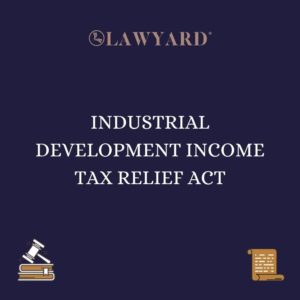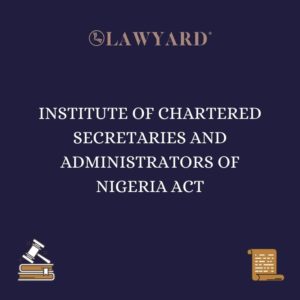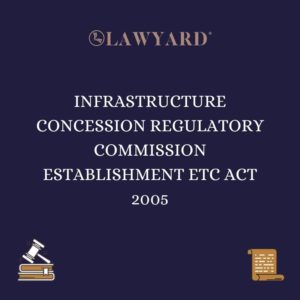Raising Fresh Cause of Action: One Limit of a Counter-claim
Lawyard is a legal media and services platform that provides…
Introduction
Litigation is one of the core ways of resolving disputes across the world. It is often referred to as the last resort in the conflict resolution process. The process of litigation involves the parties submitting themselves to a Court with requisite jurisdiction to entertain their disputes upon an action commenced by one of them.
The jurisdiction of a Court is fixed by the statute creating the Court – it is the power the Court has to adjudicate or hear and determine issues presented to it by litigating parties. A party who commences an action before the Court is generally called the Plaintiff whereas the person against whom the action is filed is called the Defendant.
The Civil Procedure Rules of the various State and Federal High Courts and National Industrial Court provides for the mode of commencing different types of suits before them. Where a suit involves contentious facts, it is required to be commenced by a writ of summons and the parties are expected to file pleadings.
The Rules of Courts require a writ of summons to, among other things, be accompanied by a Statement of Claim which sets out the facts relied on by the Plaintiff as well as the Claims he is making against the Defendant. In response to the Statement of Claim, a Defendant is expected to file a Statement of Defence.
However, there are circumstances in which the Defendant may also have a claim(s) against the Plaintiff and may want to make his claims against him. Ordinarily, he should file a separate and independent action against the Plaintiff for this purpose; but for convenience, the Rules of Court allows the Defendant to counter-claim against the Plaintiff in the same suit by filing a “Statement of Defence and Counter-claim”.
This article considers the question of whether a Defendant in counter-claiming against the Plaintiff can rely on facts which emerged during the pendency of the suit.
Nature of a Counter-claim
By nature, a Counter-claim is a cross-action raised in the Defendant’s Statement of Defence. A Counter-claim is a distinct action; it is separate and has a life of its own as it survives even where the substantive action is struck out or dismissed by the Court.
The nature of a Counter-claim and its importance has received several judicial pronouncements that the law is now considered settled on its effects and/or implications.
Holding to this end, the Court of Appeal in Ogiren v. Olufunmilayo & Ors concluded that “there is no need citing any authority in support of this well-known principle of law because there is a rain of authorities on it.”
For all intent and purposes, a Counter-claim is therefore considered by the Courts to be a distinct action on its own. Thus, in Akintola v. Vice-Chancellor it was held that a Counter-claim, being a separate action, the Court must have a separate judgment for it.
A prequel to the foregoing principle is that being a separate action, the Plaintiff has to file a defence to the Counter-claim otherwise the facts contained in it would be deemed admitted. However, the foregoing rule does not apply to actions for declaration of title to lands as in such suits a party succeeds based on the strength of his case and not on the weakness of the opponent’s.
Therefore, even if no defence is filed to a Counter-claim in a suit for declaration of title to land, except the Counter-claimant proceeds to prove his case, no judgment can be entered for him.
The reason for this position is this: by nature, a judgment entered in the absence of a defence (pleadings) is a default judgment and the Courts do not allow or apply default judgments in land matters – as a matter of fact, the Courts avoid them. This was held by Adamu JCA in Inyang v Chukwuogor relying on the Supreme Court decisions in Usikaro v Usekiri Land Trustees and Aborishade v Abolarin.
Thus, in FADA v Jema’a Local Government & Ors the Plaintiff sued the Defendants for a declaration of title to certain pieces of land. The Defendants filed a Statement of Defence and Counter-claim which the Claimant/Appellant saw no need to joins issues with. The trial court held that by failing to reply to the allegations contained in the Counter-claim, the Plaintiff/Appellant had admitted them. Accordingly, the Court entered judgment for the Defendant as per the Counter-claim.
Dissatisfied with the trial Court’s Judgment, the Plaintiff appealed to the Court of Appeal. At the Court of Appeal, the issue placed before the Court was whether the failure of the Plaintiff/Appellant to had filed a reply and defence to the Defendant/Respondent’s Statement of Defence and Counter-claim justified the trial Court in entering judgment for the Defendant.
The Court disagreed with the trial Court’s judgment and held that the implication of a failure to file a reply to such a pleading is only that the Appellant has admitted the pleadings. That definitely is not the same thing as the Appellant admitting the claim of ownership of the land.
As stated by the Supreme Court in Akpaji v. Udema (2009) 6 NWLR pt 1138 p. 545 “where a plaintiff fails to or neglects to file a defence or a reply to a counter-claim, it is of no moment and it is not fatal to the claim. (Emphasis supplied). Consequently, the Court decided that the trial Court’s judgment ought to have been resolved in his favour. On the basis of this, the Court resolved the appeal in the Appellant’s favour.
Raising Fresh Cause of Action via a Counter-claim
The use and importance of a Counter-claim can by no means be over-emphasized; however, the scope of its application is limited to the extent of facts existing as at the time the plaintiff filed the writ of summons. Any fact forming the basis of a Counter-claim which arose after the date of filing of the substantive action cannot be allowed by the Court.
In General Yakubu Gowon v Mrs Edit I. Ike-Okongwu & Ors the Plaintiffs commenced an action against General Gowon and sought a declaration that the Defendant (Gowon) was the father of Musa Gowon (the second Plaintiff); damages for libel; a sum for educational expenses and upkeep of the second plaintiff. The Defendant denied the allegations and later sought to amend the Statement of Defence and include a Counter-claim.
The subject of the Counter-claim centres around a publication made by the Plaintiffs on the Hint magazine. This publication was made after the Plaintiffs had instituted the suit and pleadings exchanged by the parties. The Defendant’s motion for leave to amend the Statement of Defence and to include the Counter-claim was refused by the trial High Court and the Court of Appeal.
Dissatisfied with the judgment of the Court of Appeal, the Defendant (therein Appellant) further appealed to the Supreme Court. At the Supreme Court, the issue was “whether the Defendant should be granted leave to amend his Statement of Defence by joining to it a Counter-claim based on an entirely fresh cause of action which arose after the action had been started”.
The Supreme Court in relying on the English case of Eshelby v Fed. European Bank held that the Counter-claim cannot be allowed as the cause of action (defamation) did not accrue to the Defendant/Appellant as at the time the Plaintiffs/Respondents’ action was filed but arose subsequent to it.
The decision of the Supreme Court in the Gowon’s case has been followed by the Court of Appeal in a number of cases – the Courts considered bringing such fresh facts as beginning a new cause of action, such as Olusi & Anor v Obanobi & Ors and the case of Joint Project Development Company & Ors v. Alhaji Lateef Akinlade where the Court of Appeal in arriving at its decision restated the decision of the Supreme Court in the Gowon’s case.
Other Limitations of a Counter-claim
Apart from raising fresh cause of actions, other limitations also exist on the rights to the use of a Counter-claim. One such limitation bothers on the capacity of the Defendant and the jurisdiction of the trial Court.
According to Nwadialor, for a Defendant to use a Counter-claim in an action, the subject of the Counter-claim must be one in which he must be able to sue as a plaintiff; where this capacity is lacking a Counter-claim will fail. In addition, the trial court must have the jurisdiction to hear and determine the claim in the Counter-claim.
Another limitation to a Counter-claim, though an independent action on its own, is the fact that where the substantive suit is found to have been incompetent ab initio – say on grounds of an invalid writ-, a Counter-claim filed in response to it can no longer stand.
This issue came up for determination before the Court of Appeal in Aberuagba & Anor v Oyekan & Ors. In this case, the originating processes (the Plaintiff’s writ of summons) were defective, to wit not signed by a legal practitioner in accordance with the rule in Okafor v Nweke.
However, the trial Court proceeded to hear the suit and the Counter-claim which was filed following the suit and at the conclusion of evidence entered Judgment in favour of the Counter-claimant. Being dissatisfied with the Judgment, the Plaintiff appealed to the Court of Appeal on the ground that since the original suit was incompetent and void there was nothing the Defendant’s Counter-claim was standing on. The court of Appeal, Per Barka JCA agreed with the Appellant’s submissions
Conclusion
A Counter-claim though an important pleading which for convenience is allowed to be tried together in the substantive suit, does not carry with it a right to bring along new facts emerging after the originating process was taken out by the plaintiff; the pleading is limited to facts which existed as at the time the action was filed and no more.
Therefore, if a Defendant intends to make a claim based on facts that emerged after the original writ was filed, he must institute a fresh suit embodying this new cause of action. This is because bringing in such a fresh cause of action only means one thing: starting a new cause of action, and one which did not accrue, and therefore could not have been sued upon, at the time the action was brought.
Author
Lawrence Oguama LL.B, BL is an associate at E&P Legal, Lagos, Nigeria. He can be reached through oguamalawrence@gmail.com
Lawyard is a legal media and services platform that provides enlightenment and access to legal services to members of the public (individuals and businesses) while also availing lawyers of needed information on new trends and resources in various areas of practice.













